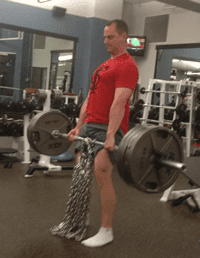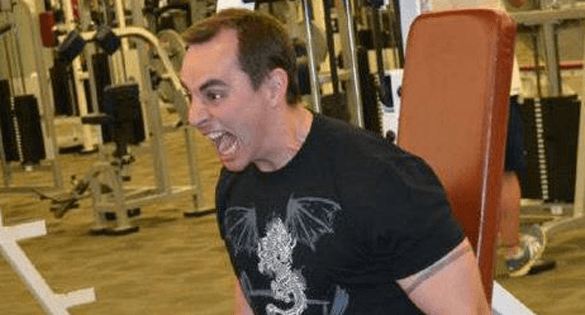This is a guest post by Dean Somerset.
When I was about 4 or 5 years old, my dad wound up injuring his back at work. He had to spend 6 weeks on the couch before he could get surgery. The injury was diagnosed as a herniated disc and as a result could barely put any kind of pressure on his legs. As he was the breadwinner of the family with three young boys (I'm the youngest).
I was very young and there was little I could do to help out except bring my dad some food and water when he needed it. You could say that his issues probably planted the seed of me wanting to work with clients coming back from injury and pain.

The common treatment for low back pain back in those days was rest, which is a bad idea as it allows the affected areas to atrophy and become less stable and healthy. On top of this, a reduction in blood flow through the area prevents the delivery of blood born nutrients and removal of waste products to the area, which could help to expedite healing and reduce pain sensation from biomechanical irritation and inflammation.
When he went into surgery, arthroscopy had yet to be invented, which meant a full open surgical intervention. This meant cutting through many layers of active tissue in order to get to the disc to repair it.
As was the current best practices of the time, he went through a microdiscectomy, which involved an open incision of about 3 inches along the spine, cutting through the layers of fascia and connective tissue, and the use of a surgical microscope to locate the disc.
Prior to the MRI, the surgeon was having to go blind, so to speak, using only his naked eye to locate the right spot and without any actual knowledge of whether the disc herniation was big, small, or how pervasive it was.
The primary method of getting to the disc was severing the transverse abdominis and localized lumbar multifidus muscles, as well as cutting out a section of lumbodorsal fascia. Looking back, the result of detaching the multifidus and transverse cannot be overstated, especially in light of so much rehabilitative research about those two specific muscles.
The fascia is also insanely important in recovering from any spinal surgery, so having it removed was a massive player in my dad having a chronic history of low back pain following the surgery.
Follow up treatment from the surgery was spending a few days in hospital to recover from the anaesthesia, followed by discharge to home and a sheet of some small exercises to get back to walking and eventually back to work.
Looking back, this procedure was poor for patient outcomes, especially given all the structures cut through and excises, however at the time it was considered best practices, done by one of the best surgeons in the area, and a specialist in that specific type of surgery.
Cutting through muscles has been rendered relatively obsolete with the advent of arthroscopy, and naked-eye interventions has been replaced with computer guided and fluoroscopic imaging techniques for improved accuracy, reduced side effects of intervention, and better long-term outcomes in strength, pain-free living, and functional stability of the area.
This advancement of techniques and procedures is not isolated to just the medical field. In talking with Dr. Randy Gregg, a family and sport physician who was also a member of the 5 Stanley Cup championships with the Edmonton Oilers in the 80's and early 90's, he said that their typical gym training was identical to a bodybuilder routine, split by body part and rotated on a weekly basis, which also involved a fair degree of machine-based isolation techniques to get the muscles fired up and worked out.
In talking with Simon Bennett, the current strength coach of the Edmonton Oilers, their training program is nearly indistinguishable from their early years, and involves much more sport-specific, 3D and speed-based training as well as a focus on soft tissue work than in the glory years.
All of this is to say that what we believe we absolutely "know" today will inevitably be proven incorrect, advanced with future technology, or deemed irrelevant by newer discoveries and techniques.
What was considered good treatment for rotator cuff irritations 10 years ago is now superfluous and outdated. Training methods have shown injury rates that can adjust how training is done, and help people live longer and more productive gym lives with a lower risk of injury, while also getting after it and seeing better progress than ever before, but that will change as well.
The only constant in life is change.
The ability of trainers to continue to learn and stay abreast of current research and techniques will help further the industry as a whole, as well as help us get better results for our clients.
The willingness to discard training methods used for years with the introduction of new techniques and results-driven data that shows a superior method can be one of the most challenging yet simplest things to do to see an expansion of a training business based on results attained for the clients, but can also allow trainers to stay one step ahead of the competition.
For instance, common practice for ACL rehabilitation 10 years ago was the introduction of unstable surface training to increase proprioception, ¾ range of motion leg extension machine work to recruit more of the vastus medialis obliquus to prevent patellofemoral tracking issues, and prone eccentric hamstring curls to rebuild hamstring strength and building up time on the bike to encourage aerobic adaptation and oxygen delivery to the muscles. The glutes were considered peripheral muscles, involved but not something that was directly trained very often, and decelerative training was something that was used in near end-stage rehab.
Current trends involve much more dynamic stabilization drills, earlier in the rehab timetable, as well as more compound strength training and 3D hip training in order to decrease shear forces acting on the knee.
More focus is being placed on core strength and firing sequence than ever before, as it's one of the main driving factors to controlling anterior displacement of the femur during deceleration, and also to reduce rotational forces acting on the knee during pivoting and cutting movements, which is left unchecked can decimate the knee.
Surgical interventions have also advanced, reducing the use of a patellar tendon graft choice to repair the ACL and opting for more of the semitendinosus graft for athletic populations due to the easier rehab of the graft site, greater oxygenation of the graft tissue long term, and easier return to sport. The use of allografts (cadaver ACLs) is popular, but seems to be showing an increased laxity compared to the other options, which can be very concerning for return to multidirectional sports.
Again, it's always changing as our knowledge expands, technology advances, data is collected, and results are tracked. We will always be chasing the impossible goal of perfection, which is the reason why we all do what we do. When I get great results for my clients, I always ask "how could I get them better results?" I'm sure you're no different. The relentless pursuit of excellence drives all industries, and ours is no exception. Keep learning, advancing, and getting comfortable with change.










